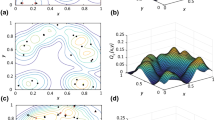Summary
In this chapter various CA models for random particle movement have been introduced. Movement of individual particles was assumed as basically independent. Accordingly, no cooperative effects, particularly spatial patterns, can be expected. Initial patterns are always destroyed due to the underlying diffusive particle behavior. In order to create patterns out of uniformity, particles have to interact with each other (e.g., DLA growth). In the following chapters various cellular interactions are analyzed in corresponding CA models.
Access this chapter
Tax calculation will be finalised at checkout
Purchases are for personal use only
Preview
Unable to display preview. Download preview PDF.
Similar content being viewed by others
Rights and permissions
Copyright information
© 2005 Birkhäuser Boston
About this chapter
Cite this chapter
(2005). Random Movement. In: Cellular Automaton Modeling of Biological Pattern Formation. Modeling and Simulation in Science, Engineering and Technology. Birkhäuser Boston. https://doi.org/10.1007/0-8176-4415-6_5
Download citation
DOI: https://doi.org/10.1007/0-8176-4415-6_5
Publisher Name: Birkhäuser Boston
Print ISBN: 978-0-8176-4281-5
Online ISBN: 978-0-8176-4415-4
eBook Packages: Mathematics and StatisticsMathematics and Statistics (R0)




